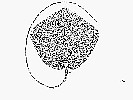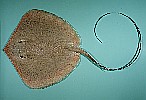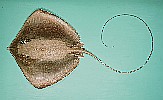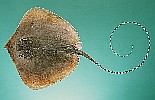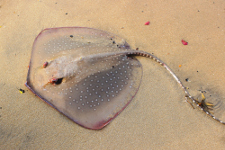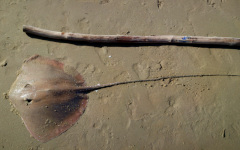Maculabatis gerrardi
(Gray, 1851)
Sharpnose stingray
Classification: Elasmobranchii Myliobatiformes Dasyatidae
Reference of the original description
List of the specimens of fish in the collection of the British Museum. Part I. Chondropterygii. British Museum (Natural History), London, 160 pp
List of the specimens of fish in the collection of the British Museum. Part I. Chondropterygii. British Museum (Natural History), London, 160 pp
Image of the original description
No image in first description.
No image in first description.
Synonyms / new combinations and misspellings
Dasyatis alcockii, Dasyatis gerrardi, Dasyatis gerrardii, Dasyatis (Himantura) alcockii, Dasyatis (Himantura) gerrardi, Dasybatus alcockii, Dasybatus gerrardi, Himantura alcocki, Himantura alcockii, Himantura cf. gerrardi, Himantura gerrardi, Himantura gerrardii, Trygon alcockii, Trygon gerrardi, Trygon gerrardii, Trygon liocephalus, Trygon macrurus, Trygon (Himantura) macrurus
Dasyatis alcockii, Dasyatis gerrardi, Dasyatis gerrardii, Dasyatis (Himantura) alcockii, Dasyatis (Himantura) gerrardi, Dasybatus alcockii, Dasybatus gerrardi, Himantura alcocki, Himantura alcockii, Himantura cf. gerrardi, Himantura gerrardi, Himantura gerrardii, Trygon alcockii, Trygon gerrardi, Trygon gerrardii, Trygon liocephalus, Trygon macrurus, Trygon (Himantura) macrurus
Types
Maculabatis gerrardi
Himantura alcockii
Holotype: ZSI: F2474/1;
Himantura gerrardi
Syntype: BMNH: 1846.11.18.49 BMNH: 1843.5.19.1 RMNH: 7442
Trygon liocephalus
Holotype: ZMB: 8083
Trygon macrurus
Syntype: BMNH: 1867.11.28.160 NMV: A949 RMNH: 8009 RMNH: 7442 RMNH: 8008 SMNS: 10594;
Maculabatis gerrardi
Himantura alcockii
Holotype: ZSI: F2474/1;
Himantura gerrardi
Syntype: BMNH: 1846.11.18.49 BMNH: 1843.5.19.1 RMNH: 7442
Trygon liocephalus
Holotype: ZMB: 8083
Trygon macrurus
Syntype: BMNH: 1867.11.28.160 NMV: A949 RMNH: 8009 RMNH: 7442 RMNH: 8008 SMNS: 10594;
Description :
Citation: Maculabatis gerrardi (Gray, 1851): In: Database of modern sharks, rays and chimaeras, www.shark-references.com, World Wide Web electronic publication, Version 04/2024
Please send your images of "Maculabatis gerrardi" to info@shark-references.com
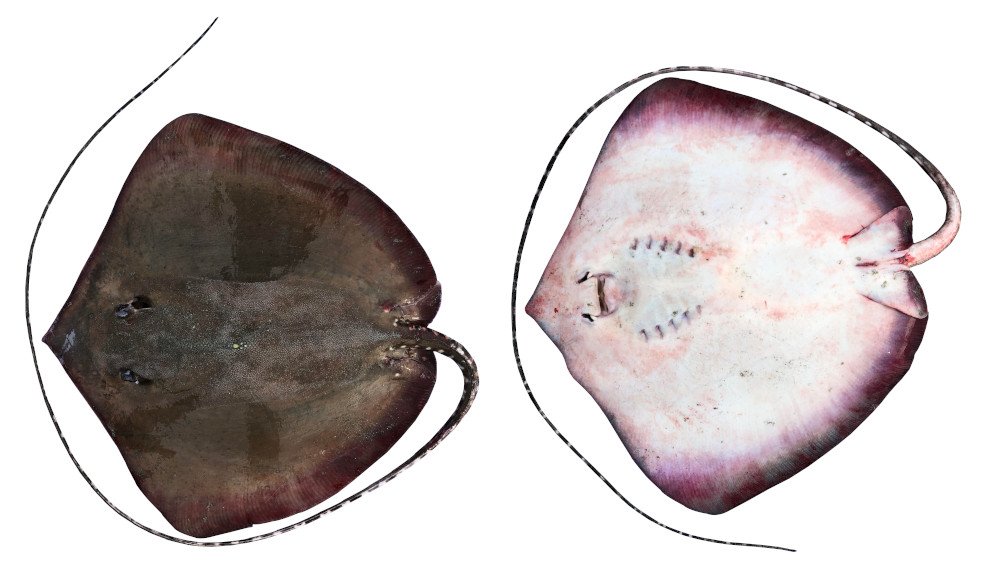
Maculabatis gerrardi (Gray, 1851), male, 41.3 cm TL, 45.1 cm DW, 4.356 kg, Bangladesh © G. M. MASUM BILLAH, Program Coordinator- Marine Mega-Fauna & Fisheries, Wildlife Conservation Society- Bangladesh Program (masumwcsbd@gmail.com)

Maculabatis gerrardi (Gray, 1851), male, 41.3 cm TL, 45.1 cm DW, 4.356 kg, Bangladesh © G. M. MASUM BILLAH, Program Coordinator- Marine Mega-Fauna & Fisheries, Wildlife Conservation Society- Bangladesh Program (masumwcsbd@gmail.com)
Common names
 Banded whiptail ray,
Banded whiptail ray,  Bluntnose whip ray,
Bluntnose whip ray,  Bluntnose whiptail ray,
Bluntnose whiptail ray,  Sharpnose stingray,
Sharpnose stingray,  Whipray,
Whipray,  Whitespotted whipray,
Whitespotted whipray,  Uge cauda-espinhosa
Uge cauda-espinhosa
 Banded whiptail ray,
Banded whiptail ray,  Bluntnose whip ray,
Bluntnose whip ray,  Bluntnose whiptail ray,
Bluntnose whiptail ray,  Sharpnose stingray,
Sharpnose stingray,  Whipray,
Whipray,  Whitespotted whipray,
Whitespotted whipray,  Uge cauda-espinhosa
Uge cauda-espinhosa
Short Description
Descripgtion after KIZHAKUDAN et al. 2018 [27046]: Large sized whipray with a rhomboidal disc and narrowly rounded apices; anterior margin of disc almost straight; snout broadly triangular with small tip;dDenticle band narrow, not extending to tail base (in juveniles restricted to central disc) some enlarged denticles before and after pearl-like tubercular thorn, widely spaced; tail very slender, elongate, whip-like beyond sting, no cutaneous folds on tail; surface of disc usually paler greenish grey/greyish brown with numerous white spots posteriorly (rarely plain), tail banded beyond sting
Descripgtion after KIZHAKUDAN et al. 2018 [27046]: Large sized whipray with a rhomboidal disc and narrowly rounded apices; anterior margin of disc almost straight; snout broadly triangular with small tip;dDenticle band narrow, not extending to tail base (in juveniles restricted to central disc) some enlarged denticles before and after pearl-like tubercular thorn, widely spaced; tail very slender, elongate, whip-like beyond sting, no cutaneous folds on tail; surface of disc usually paler greenish grey/greyish brown with numerous white spots posteriorly (rarely plain), tail banded beyond sting
Distribution
Indo-Pacific: India to New Guinea, north to Japan. Reported from the Red Sea and east African coast but these western records need to be confirmed. Collected from the estuary and freshwater of the River Ganges [5700]. Probably a species complex [529]. Source: www.gbif.org
Indo-Pacific: India to New Guinea, north to Japan. Reported from the Red Sea and east African coast but these western records need to be confirmed. Collected from the estuary and freshwater of the River Ganges [5700]. Probably a species complex [529]. Source: www.gbif.org
Human uses
fisheries: commercial; gamefish: yes
fisheries: commercial; gamefish: yes
Biology
Exhibit ovoviparity (aplacental viviparity), with embryos feeding initially on yolk, then receiving additional nourishment from the mother by indirect absorption of uterine fluid enriched with mucus, fat or protein through specialised structures [733]. Distinct pairing with embrace [17086]. Bears 2 young in summer [536]. Gives birth to litters of 1-4 pups; born at 18-21 cm WD [2539]. Likely confined to the inner continental shelf (Ref. 9840), over sandy and mud bottoms [20218]. Inhabits coral reefs (Ref. 58534). Feeds on bottom crustaceans including shrimp, crabs and small lobsters.
Exhibit ovoviparity (aplacental viviparity), with embryos feeding initially on yolk, then receiving additional nourishment from the mother by indirect absorption of uterine fluid enriched with mucus, fat or protein through specialised structures [733]. Distinct pairing with embrace [17086]. Bears 2 young in summer [536]. Gives birth to litters of 1-4 pups; born at 18-21 cm WD [2539]. Likely confined to the inner continental shelf (Ref. 9840), over sandy and mud bottoms [20218]. Inhabits coral reefs (Ref. 58534). Feeds on bottom crustaceans including shrimp, crabs and small lobsters.
Size / Weight / Age
-116 cm (~350 cm TL), males mature at 48-58 cm DW, females 63 cm DW, born at 13-21 cm DW [24880]
-116 cm (~350 cm TL), males mature at 48-58 cm DW, females 63 cm DW, born at 13-21 cm DW [24880]
Remarks
shark-references Species-ID=14650;
shark-references Species-ID=14650;
Parasites (arranged by Jürgen Pollerspöck)
Monogenea
Cestoda
Monogenea
- Decacotyle youngi (Timofeeva, 1983) Chisholm & Whittington, 1998 [17440]
- Dendromonocotyle citrosa Vaughan, Chisholm & Christison, 2008 [21242] [27172]
- Dendromonocotyle colorni Chisholm, Whittington & Kearn, 2001 [21242] [9460]
- Dendromonocotyle lotteri Vaughan & Chisholm, 2009 [9460]
- Dendromonocotyle ukuthena Vaughan, Chisholm & Christison, 2008 [21242] [27172]
- Empruthotrema dasyatidis Whittington & Kearn, 1992 [7581]
- Merizocotyle australensis (Beverley-Burton & Williams, 1989) Chisholm, Wheeler & Beverley-Burton, 1995 [15785]
Cestoda
- Anteropora cuba Mojica, Jensen & Caira, 2013 [19735]
- Corollapex sp. [25262]
- Divaricobothrium tribelum Caira, Healy, Marques & Jensen, 2017 [25321]
- Dollfusiella parva Schaeffner & Beveridge, 2013 [19694] [19694] [21816]
- Dollfusiella sp. [25611] [31083]
- Dollfusiella spinulifera (Beveridge & Jones, 2000) [21816]
- Halysiorhynchus macrocephalus (Shipley & Hornell, 1906) [21816]
- Kotorella pronosoma (Stossich, 1901) [16112] [21816] [31083] [32432]
- Oncomegas celatus (Beveridge & Campbell, 2005) [21816]
- Parachristianella baverstocki Beveridge, 1990 [21816] [31083]
- Parachristianella indonesiensis Palm, 2004 [21816] [25611] [31083]
- Parachristianella monomegacantha Kruse, 1959 [21816] [31083]
- Parachristianella sp. [31083]
- Polypocephalus sp. [20454]
- Prochristianella butlerae Beveridge, 1990 [21816]
- Prochristianella clarkeae Beveridge, 1990 [17404] [21816]
- Rhinebothrium atabaki Golzarianpour, Malek, Golestaninasab, Sarafrazi & Kochmann, 2021 [29351]
- Rhinebothrium sp. [20454]
- Rhinoptericola aetobatidis (Shipley & Hornell, 1906) [21816]
- Rhinoptericola butlerae (Beveridge & Campbell, 1988) [30611]
- Stillabothrium davidcynthiaorum Daigler & Reyda, 2016 [24898]
- Tetragonocephalum sp. [20454]
- Tetrarhynchobothrium sp. [15747]
- Trygonicola macroporus (Shipley & Hornell, 1906) [15747] [21816]








